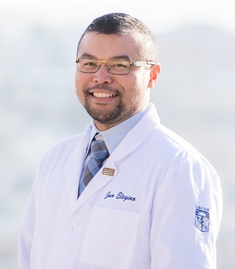Entering osteopathic medical school with years of experience as a registered nurse and a physician assistant was supposed to be easy. Having placed central/arterial lines, performed lumbar punctures, and inserted hundreds of IVs over the years, I felt like my hands were skilled in palpation and ready to tackle osteopathic manipulative treatment. As a registered nurse trained in nursing holistic models and a physician assistant trained in the allopathic disease-centered model, I thought the holistic care that osteopathic physicians provided was merely the combination of the two. I had no idea how the summation of my past experiences would only represent a portion of the profession of osteopathic medicine.
Everything about my thought process regarding osteopathic medicine changed starting on my first day of osteopathic principles and practices instruction. My skilled hands were not sensitive enough to feel subtle tissue texture changes or cranial movements, and the osteopathic tenets challenged my preconceived notions of holistic medicine. I quickly learned that the summation of holistic and disease-centered care did not equal osteopathic medicine. As a result, what I already knew and what I was currently learning became virtually incompatible.
Halfway through my first year of medical school, I started to think that I was not a good fit for the osteopathic profession. I became frustrated and even started to second-guess my decision to return to school. I allowed my frustration to grow during the winter break, and it festered into distress. And yet, I had seen firsthand on the battlefields and in clinics just how much the practice of osteopathic medicine could help people. Having been previously influenced by osteopathic physicians in the army, I knew that I wanted to become an osteopathic physician in order to utilize both my knowledge to treat and my hands to heal. I didn't want to give up, and I recognized that I needed help to achieve my goals.
I returned to school for the second semester and reached out to my osteopathic principles and practices professor, Kevin Thomas, DO, MS Med Ed, to express my concerns. His polished active listening skills and astute diagnostic abilities were used this time not to detect disease but rather to deduce the issue underlying my frustration. His diagnosis: I was being arrogant and pompous. And he was right.
I had allowed my previous training to let me become arrogant and pompous, not only in the way I practiced medicine but in the way I viewed medicine. I viewed the way I nursed and practiced as the only possible standard of care, thus making it difficult for me to conceive any new care paradigm. Having previously convinced myself that I already possessed the abilities needed to be a successful osteopathic physician, I also struggled with my position as a learner and allowed my prior training to obstruct my education. However, by recognizing my misconceptions, I was able to bring down the barriers that prohibited me from truly understanding what it means to be an osteopathic physician. I began working with Dr. Thomas several times a month, focusing on how to fuse, rather than replace, my past experiences with the principles of osteopathic medicine in order to create truly comprehensive care plans for patients.
Like osteopathic manipulative medicine itself, learning to become an osteopathic physician requires plenty of practice. My time spent practicing manipulation and learning how to integrate the tenets into treatment plans has slowly changed how I see disease and disease management. Through practice and collaboration with my mentor, my entire approach to medicine has changed.
Regardless of how difficult this process has been and the inner turmoil that I initially felt, I finally understand how osteopathic physicians provide truly holistic care. As physicians, we will utilize our knowledge to provide the standard of care. As osteopaths, we will use our trained hands to go above the standard to advance our diagnostic skills and provide osteopathic manipulation in our efforts to assist the body in its return to homeostasis. Overall, as osteopathic physicians, we will improve the practice of those around us by demonstrating the power of our tenets and showing our peers that, as the founder of osteopathic medicine put it, “To find health should be the object of the doctor. Anyone can find disease” (1).
When asked what is osteopathic medicine, I used to describe the profession as simply providing holistic care. During my time studying at an osteopathic medical school, however, I have come to realize that this explanation does not comprehensively reflect our profession’s identity. If asked the same question today, my answer would be this: Osteopathic medicine is a community of physicians built on interwoven tenets that guide their approach to disease while enhancing health and healing through their hands and can’t be compared to any other medical profession. In the end, the interrelated principles of treating patients make osteopathic medicine so much more than just the sum of its parts.
|
Jun U. Elegino, PA-C, MPAS, RN, BSN |
 |
Reference
1. Stark JE. Quoting A.T. Still with rigor: an historical and academic review. J Am Osteopath Assoc. 2012;112:366-73. [PMID: 22707646]
Back to June 2016 Issue of IMpact

